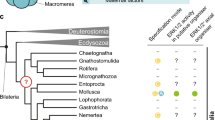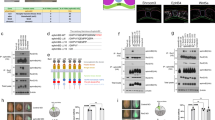Abstract
Remodelling its shape, or morphogenesis, is a fundamental property of living tissue. It underlies much of embryonic development and numerous pathologies. Convergent extension (CE) of the axial mesoderm of vertebrates is an intensively studied model for morphogenetic processes that rely on cell rearrangement. It involves the intercalation of polarized cells perpendicular to the antero-posterior (AP) axis, which narrows and lengthens the tissue1,2. Several genes have been identified that regulate cell behaviour underlying CE in zebrafish and Xenopus. Many of these are homologues of genes that control epithelial planar cell polarity in Drosophila1,2,3,4,5. However, elongation of axial mesoderm must be also coordinated with the pattern of AP tissue specification to generate a normal larval morphology. At present, the long-range control that orients CE with respect to embryonic axes is not understood. Here we show that the chordamesoderm of Xenopus possesses an intrinsic AP polarity that is necessary for CE, functions in parallel to Wnt/planar cell polarity signalling, and determines the direction of tissue elongation. The mechanism that establishes AP polarity involves graded activin-like signalling and directly links mesoderm AP patterning to CE.
This is a preview of subscription content, access via your institution
Access options
Subscribe to this journal
Receive 51 print issues and online access
$199.00 per year
only $3.90 per issue
Buy this article
- Purchase on Springer Link
- Instant access to full article PDF
Prices may be subject to local taxes which are calculated during checkout



Similar content being viewed by others
References
Keller, R. Shaping the vertebrate body plan by polarized embryonic cell movements. Science 298, 1950–1954 (2002)
Wallingford, J. B., Fraser, S. E. & Harland, R. M. Convergent extension: the molecular control of polarized cell movement during embryonic development. Dev. Cell 2, 695–706 (2002)
Mlodzik, M. Planar cell polarization: do the same mechanisms regulate Drosophila tissue polarity and vertebrate gastrulation? Trends Genet. 18, 564–571 (2002)
Tada, M. & Smith, J. C. Xwnt11 is a target of Xenopus Brachyury: regulation of gastrulation movements via dishevelled, but not through the canonical Wnt pathway. Development 127, 2227–2238 (2000)
Heisenberg, C. P. et al. Silberblick/Wnt11 mediates convergent extension movements during zebrafish gastrulation. Nature 405, 76–81 (2000)
Smith, J. C., Price, B. M., Green, J. B., Weigel, D. & Herrmann, B. G. Expression of a Xenopus homolog of Brachyury (T) is an immediate–early response to mesoderm induction. Cell 67, 79–87 (1991)
Sasai, Y. et al. Xenopus chordin: a novel dorsalizing factor activated by organizer-specific homeobox genes. Cell 79, 779–790 (1994)
Keller, R. & Danilchik, M. Regional expression, pattern and timing of convergence and extension during gastrulation of Xenopus laevis. Development 103, 193–209 (1988)
Klein, P. S. & Melton, D. A. A molecular mechanism for the effect of lithium on development. Proc. Natl Acad. Sci. USA 93, 8455–8459 (1996)
Sokol, S. & Melton, D. A. Pre-existent pattern in Xenopus animal pole cells revealed by induction with activin. Nature 351, 409–411 (1991)
Ninomiya, H., Takahashi, S., Tanegashima, K., Yokota, C. & Asashima, M. Endoderm differentiation and inductive effect of activin-treated ectoderm in Xenopus. Dev. Growth Differ. 41, 391–400 (1999)
McDowell, N., Zorn, A. M., Crease, D. J. & Gurdon, J. B. Activin has direct long-range signalling activity and can form a concentration gradient by diffusion. Curr. Biol. 7, 671–681 (1997)
Green, J. B., New, H. B. & Smith, J. C. Responses of embryonic Xenopus cells to activin and FGF are separated by multiple dose thresholds and correspond to distinct axes of the mesoderm. Cell 71, 731–739 (1992)
Gurdon, J. B., Harger, P., Mitchell, A. & Lemaire, P. Activin signalling and response to a morphogen gradient. Nature 371, 487–492 (1994)
Gurdon, J. B. et al. Single cells can sense their position in a morphogen gradient. Development 126, 5309–5317 (1999)
Thisse, B., Wright, C. V. E. & Thisse, C. Activin- and nodal-related factors control antero-posterior patterning of the zebrafish embryo. Nature 403, 425–428 (2000)
Gritsman, K., Talbot, W. S. & Schier, A. F. Nodal signaling patterns the organizer. Development 127, 921–932 (2000)
Branford, W. W. & Yost, H. J. Lefty-dependent inhibition of Nodal- and Wnt-responsive organizer gene expression is essential for normal gastrulation. Curr. Biol. 12, 2136–2141 (2002)
Irvine, K. D. & Wieschaus, E. Cell intercalation during Drosophila germband extension and its regulation by pair-rule segmentation genes. Development 120, 827–841 (1994)
Zallen, J. A. & Wieschaus, E. Patterned gene expression directs bipolar planar polarity in Drosophila. Dev. Cell 6, 343–355 (2004)
Sokol, S. Y., Klingensmith, J., Perrimon, N. & Itoh, K. Dorsalizing and neuralizing properties of Xdsh, a maternally expressed Xenopus homolog of dishevelled. Development 121, 1637–1647 (1995)
Rothbächer, U. et al. Dishevelled phosphorylation, subcellular localization and multimerization regulate its role in early embryogenesis. EMBO J. 19, 1010–1022 (2000)
Wallingford, J. B. et al. Dishevelled controls cell polarity during Xenopus gastrulation. Nature 405, 81–85 (2000)
Townes, P. L. & Holtfreter, J. Directed movements and selective adhesion of embryonic amphibian cells. J. Exp. Zool. 128, 53–120 (1955)
Kinoshita, N., Iioka, H., Miyakoshi, A. & Ueno, N. PKCδ is essential for Dishevelled function in a noncanonical Wnt pathway that regulates Xenopus convergent extension movements. Genes Dev. 17, 1663–1676 (2003)
Goto, T. & Keller, R. The planar cell polarity gene strabismus regulates convergence and extension and neural fold closure in Xenopus. Dev. Biol. 247, 165–181 (2002)
Jessen, J. R. et al. Zebrafish trilobite identifies new roles for strabismus in gastrulation and neuronal movements. Nature Cell Biol. 4, 610–615 (2002)
Strutt, D. Frizzled signalling and cell polarisation in Drosophila and vertebrates. Development 130, 4501–4513 (2003)
Smith, J. C. & Watt, F. M. Biochemical specificity of Xenopus notochord. Differentiation 29, 109–115 (1985)
Gwantka, V., Ellinger-Ziegelbauer, H. & Hausen, P. β1-Integrin is a maternal protein that is inserted into all newly formed plasma membranes during early Xenopus embryogenesis. Development 115, 595–605 (1992)
Acknowledgements
We thank the National Hormone & Pituitary Program and A. F. Parlow for recombinant human activin A; F. Watt for MZ15 antibody; P. Hausen for 8C8 antibody; E. M. DeRobertis, R. Harland and J. Smith for plasmids; Y. Masui and the members of the Elinson and Winklbauer laboratories for help and encouragement; and M. Makowiecki for manuscript suggestions. This work was supported by an International Collaborative Grant from the Human Frontier Science Program Organization to R.P.E. and by grants from the Natural Sciences and Engineering Research Council of Canada, the Canadian Institutes of Health Research, and the Canada Foundation for Innovation to R.W.
Author information
Authors and Affiliations
Corresponding author
Ethics declarations
Competing interests
The authors declare that they have no competing financial interests.
Supplementary information
Supplementary Methods
Includes information on embryological manipulations and immunohistochemistry and in situ hybridization. (DOC 30 kb)
Rights and permissions
About this article
Cite this article
Ninomiya, H., Elinson, R. & Winklbauer, R. Antero-posterior tissue polarity links mesoderm convergent extension to axial patterning. Nature 430, 364–367 (2004). https://doi.org/10.1038/nature02620
Received:
Accepted:
Issue Date:
DOI: https://doi.org/10.1038/nature02620
This article is cited by
-
3D cell segregation geometry and dynamics are governed by tissue surface tension regulation
Communications Biology (2023)
-
A novel role of the organizer gene Goosecoid as an inhibitor of Wnt/PCP-mediated convergent extension in Xenopus and mouse
Scientific Reports (2017)
-
A positional Toll receptor code directs convergent extension in Drosophila
Nature (2014)
-
Sophistications of cell sorting
Nature Cell Biology (2008)
-
Epithelial coating controls mesenchymal shape change through tissue-positioning effects and reduction of surface-minimizing tension
Nature Cell Biology (2008)
Comments
By submitting a comment you agree to abide by our Terms and Community Guidelines. If you find something abusive or that does not comply with our terms or guidelines please flag it as inappropriate.



